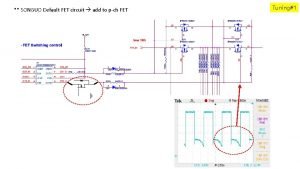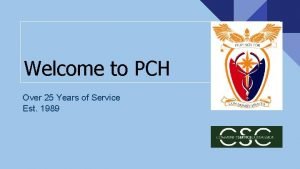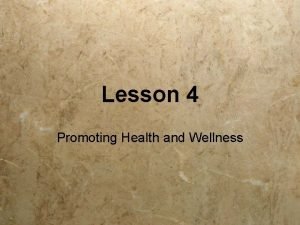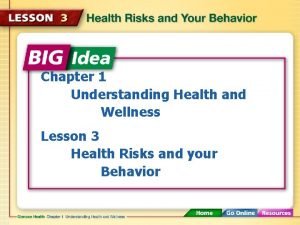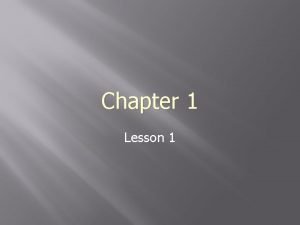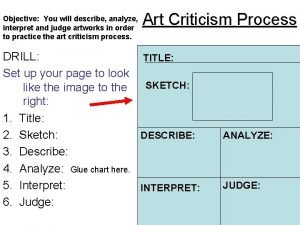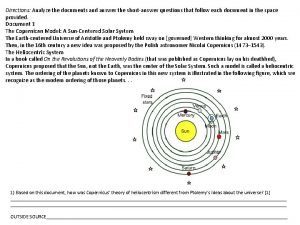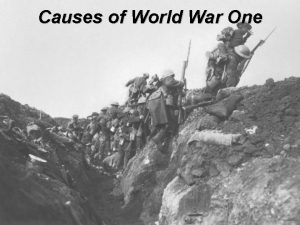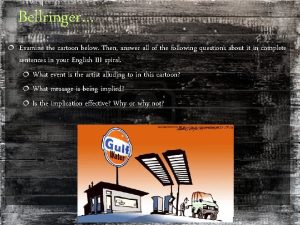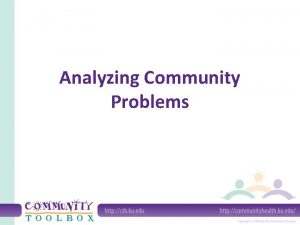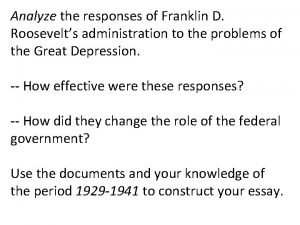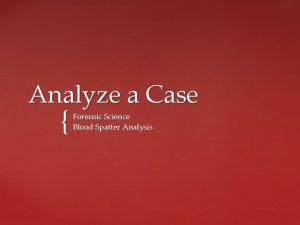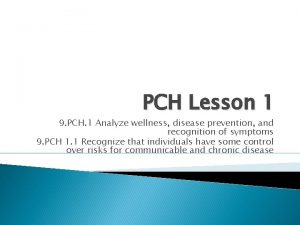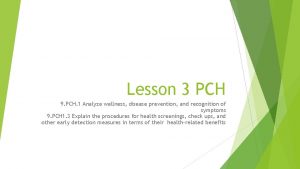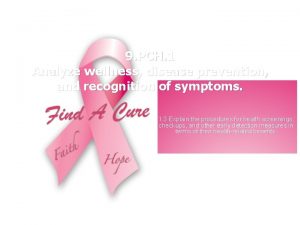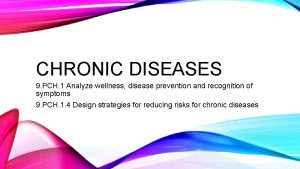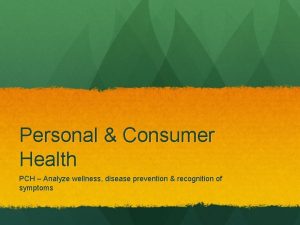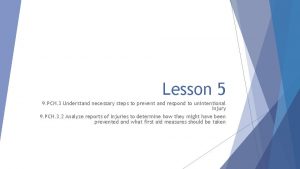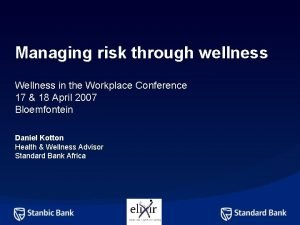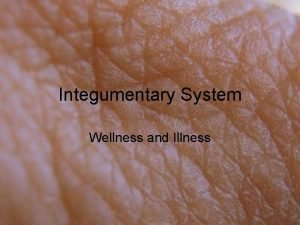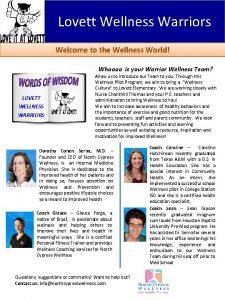PCH Lesson 2 9 PCH 1 Analyze wellness





























- Slides: 29

PCH Lesson 2 9. PCH. 1 Analyze wellness, disease prevention and recognition of symptoms 9. PCH 1. 2 Summarize the procedures for organ donation, local and state recourses and benefits

Table of Contents � 1. � 2. � 3. � 4. � 5. What does health mean to me? Getting Acquainted with Health PCH Notes Risky Business Take Control � 6. Organ Donation and Transplantation Assessments � 7. Stories of Hope � 8. Letter to a Donor � 9. Organ and Tissue Donation Guided Notes 11/6 11/6 11/13

Warm Up 11/13 - PCH Notes � What ◦ ◦ do you know about Organ Donation Do you agree with it, not agree? Do you know the process? What can and cannot be donated Living vs non-living donations? � What is your current decision on becoming a donor?

Statement of Objectives � By the end of this lesson, each of you should be able to explain the organ donation process and should know fact from myth in regard to this procedure, state and federal resourses available regarding donation, and the benefits of donation to recipients and to society. � Students will understand that organ donation is the greatest gift one can offer

Focus: Jason Ray Story- ESPN’s Ray Of Hope � https: //www. youtube. com/watch? v=s. Ak. Npd 7 LDFI � https: //www. youtube. com/watch? v=5 rzk. Xwb L 1 Mg ** Complete ESPN’s Ray of Hope questions (pg. 7)

Fact vs Myth � Many believe that a doctor will not work as hard to save someone’s life if that person is an organ donor. � Fact is that the doctors in an emergency room are not a part of the organ donation process and will not give up on a patient just because he or she is a donor The type of medical care you receive is not influenced by your designation as a donor

Two ways to become a donor � At the DMV when getting a driver’s license � At an online registration website available for all states � http: //donatelifenc. org �A heart on a license indicates an organ donor

Organ/ Tissue Donation Notes • Rich and famous people do not receive donated organs/tissues quicker than others Majority of religions encourage organ and tissue donation An organ donor can still have a customary funeral and an open casket, if desired

Organ/Tissue Donation Notes There are 2 types of donors: living and deceased One organ and tissue donor can save, or improve, the lives of 50 people or more More than 100, 000 people are on the national transplant waiting list right now A new name is added to the list every 13 minutes

Organ Donation/Tissue Notes • Every 27 minutes someone receives an organ transplant • Blood donors must be 17 years old • 16 with parent permission Kidney transplants are more successful when the donor and recipient are from the same ethnic or racial background

Organ/ Tissue Donation Notes • Medical factors used in determining who receives an organ transplant: n. Size of organ n. Blood type n. Degree of illness

Organ/ Tissue Donation Notes At the end of the donation process, general information about the recipients of donated organs are given to the family The recipient’s family picks up the medical costs from the organ banks for organ recovery and surgery. No expenses to the donor’s family

Organ Procurement Organization �OPO is a local organization contracted by the hospital in the event of a death or impending death in the hospital �A representative from this organization discusses the organ donation with the loved ones of the organ donor. �It is illegal to buy and sell organs and tissue for transplant in the US

Activity- Organ Donation Process � Samantha: is an inexperienced teenage driver who hydroplaned into oncoming traffic which resulted in a head-on crash. Samantha is rushed to the hospital Emergency Room with head injuries from a car accident. Her head injury is causing her brain to swell, cutting off its blood supply. Without blood flow, the brain tissue begins to die

Samantha’s Mom and Dad � Samantha’s parents rush to the hospital as soon as the hospital calls them. They are hoping that the doctors can save Samantha’s life. The Emergency Department doctors and nurses assure Samantha’s parents that they are doing everything that can to help Samantha, but they explain that her head injury is severe and she may not recover.

Emergency Department Physician � In the Emergency Room, the doctors and nurses try to save Samantha’s life. Because she had stopped breathing on her own, she was put on a ventilator, a machine that supports the body functions and keeps oxygen flowing through her blood. However, her brain swelling has continued and the doctors fear that she no longer has any blood flow to the brain, which means she could be brain dead.

EC Cont. � The ED physician calls a neurologist, who can do tests to determine the extent of Samantha’s brain injury. The Emergency Department physician and nurses keep Samantha’s parents constantly updated about Samantha’s condition.

Neurologist �A neurologist is a physician who has trained in the diagnosis and treatment of nervous system disorders, including diseases and injuries of the brain, spinal cord, nerves, and muscles. Neurologists perform examinations and tests that can determine – beyond a doubt – whether someone is brain dead. The neurologist performs these tests on Samantha and determines that she is brain dead.

Neurologist � The neurologist meets Samantha’s parents in a private waiting area and carefully and sensitively explains this to Samantha’s parents, who are very upset. The neurologist then notifies the organ procurement organization (OPO) because federal regulations require hospitals contact their local OPO in the event of a death or imminent death in their hospital. When the neurologist calls the OPO representative, they discuss Samantha’s medical status and confirm her suitability as a donor.

OPO Coordinator � After speaking with the neurologist, the OPO coordinator arrives at the hospital. The coordinator consults with the neurologist and other hospital staff to make sure that Samantha’s parents understand that Samantha has died before the issue of donation is ever raised. The OPO coordinator is there because under state and federal regulations, families of potential donors must be offered the option of donation. The OPO coordinator, in conjunction with hospital staff, discusses options with Samantha’s parents and answers all of their questions.

OPO Coordinator Cont. � Samantha’s parents think that donation is something that Samantha would want, as she told them so when she got her driver’s license. After calling other family members and talking by themselves, Samantha’s parents decide to donate her organs, eyes and tissues. They give their written consent for donation. The OPO coordinator discusses Samantha’s medical/social history with her parents to determine possible medical problems or social behavior that could put a recipient at risk. The OPO coordinator also does a thorough physical exam.

� The OPO coordinator assumes care of Samantha in the hospital. Because she is brain dead, her body is maintained by artificial means on a ventilator and stabilized with fluids and medications. Tests are conducted to determine which organs are suitable for transplant. Medical information about Samantha is sent to the United Network for Organ Sharing for matching of potential recipients.

� The OPO coordinator receives a list of possible “matches” from UNOS, the agency that maintains the national transplant waiting list. The coordinator calls the transplant center for the patient at the top of the list for each organ. It is up to the patient’s transplant surgeon to accept the organ. If declined, the next patient’s surgeon is contacted. This process continues until all organs are placed

Organ Recovery/ Transplant Surgeon � Once all organs are placed, the OPO coordinator arranges for an operating room and coordinates the arrival of the transplant surgery teams. In the operating room, the surgeons remove the organs in a surgical procedure that is extremely respectful of the nature of the gift that has been given. The organs are cooled and preserved with special solutions while he transplant teams immediately return to their hospitals to perform the transplant surgeries.

� Next Samantha’s tissues and corneas were recovered and then her body was sent to the funeral home. Samantha’s parents decided to have an open casket service.

� In a few weeks, the OPO and the Eyebank will send letters to Samantha’s family thanking them for Samantha’s gift and giving some basic information about the recipients, excluding names. For a period of time after the donation, the OPO also offers families grief resources, counseling referrals, invitations to events to honor and remember their loved ones, and coordination of donor family/recipient correspondence.

Stories of Hope � Watch the following series of videos, including � http: //espn. go. com/video/clip? id=8450635 � Complete playing Stories of Hope WS as videos are

Organ Donation Pre Assessment � Review Answers

Independent Practice Pg 6: Letter to a Donor � Imagine you are a recipient, having recently received a transplant. � Write a letter to the donor family to thank them. � Start by deciding: What organ/ tissue you received Why you needed the transplant � Elements you can include: What your life was like before the transplant How long you waited for the transplant How the transplant has changed your life � Thank the family for their generous gift
 Fet pch
Fet pch Pch outreach program
Pch outreach program Lesson 4 promoting health and wellness
Lesson 4 promoting health and wellness Chapter 1 lesson 4 promoting health and wellness
Chapter 1 lesson 4 promoting health and wellness Lesson 4 promoting health and wellness
Lesson 4 promoting health and wellness Chapter 1 understanding health and wellness lesson 2
Chapter 1 understanding health and wellness lesson 2 Chapter 1 lesson 2 what affects your health
Chapter 1 lesson 2 what affects your health Chapter 1 understanding health and wellness lesson 3
Chapter 1 understanding health and wellness lesson 3 Chapter 1 lesson 4 promoting health and wellness
Chapter 1 lesson 4 promoting health and wellness How to analyze a movie
How to analyze a movie Interpretation in art criticism
Interpretation in art criticism Part 2: epic hero: gilgamesh
Part 2: epic hero: gilgamesh Diction analysis
Diction analysis Analyze
Analyze Venn diagram of media information and technology literacy
Venn diagram of media information and technology literacy Job analysis vs job evaluation
Job analysis vs job evaluation How to analyze informational text
How to analyze informational text Analyze phase - includes
Analyze phase - includes Definition of analyze in literature
Definition of analyze in literature Directions analyze
Directions analyze Analyze algorithm
Analyze algorithm Analyze vs interpret
Analyze vs interpret Garvillo princip
Garvillo princip Analyze the cartoon below then provide answer
Analyze the cartoon below then provide answer How do you analyze your audience
How do you analyze your audience Art critique sentence starters
Art critique sentence starters Problems about community
Problems about community Analyze the ways in which the vietnam war heightened social
Analyze the ways in which the vietnam war heightened social Letter to senator robert wagner
Letter to senator robert wagner Blood spatter analyze a case
Blood spatter analyze a case
